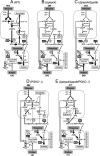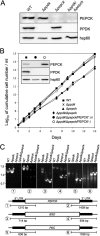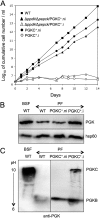Contribution of pyruvate phosphate dikinase in the maintenance of the glycosomal ATP/ADP balance in the Trypanosoma brucei procyclic form
- PMID: 24794874
- PMCID: PMC4067170
- DOI: 10.1074/jbc.M114.567230
Contribution of pyruvate phosphate dikinase in the maintenance of the glycosomal ATP/ADP balance in the Trypanosoma brucei procyclic form
Abstract
Trypanosoma brucei belongs to a group of protists that sequester the first six or seven glycolytic steps inside specialized peroxisomes, named glycosomes. Because of the glycosomal membrane impermeability to nucleotides, ATP molecules consumed by the first glycolytic steps need to be regenerated in the glycosomes by kinases, such as phosphoenolpyruvate carboxykinase (PEPCK). The glycosomal pyruvate phosphate dikinase (PPDK), which reversibly converts phosphoenolpyruvate into pyruvate, could also be involved in this process. To address this question, we analyzed the metabolism of the main carbon sources used by the procyclic trypanosomes (glucose, proline, and threonine) after deletion of the PPDK gene in the wild-type (Δppdk) and PEPCK null (Δppdk/Δpepck) backgrounds. The rate of acetate production from glucose is 30% reduced in the Δppdk mutant, whereas threonine-derived acetate production is not affected, showing that PPDK function in the glycolytic direction with production of ATP in the glycosomes. The Δppdk/Δpepck mutant incubated in glucose as the only carbon source showed a 3.8-fold reduction of the glycolytic rate compared with the Δpepck mutant, as a consequence of the imbalanced glycosomal ATP/ADP ratio. The role of PPDK in maintenance of the ATP/ADP balance was confirmed by expressing the glycosomal phosphoglycerate kinase (PGKC) in the Δppdk/Δpepck cell line, which restored the glycolytic flux. We also observed that expression of PGKC is lethal for procyclic trypanosomes, as a consequence of ATP depletion, due to glycosomal relocation of cytosolic ATP production. This illustrates the key roles played by glycosomal and cytosolic kinases, including PPDK, to maintain the cellular ATP/ADP homeostasis.
Keywords: Gene Knockout; Glucose Metabolism; Parasite Metabolism; Peroxisome; Trypanosoma brucei.
© 2014 by The American Society for Biochemistry and Molecular Biology, Inc.
Figures








Similar articles
-
Functional and molecular characterization of a glycosomal PPi-dependent enzyme in trypanosomatids: pyruvate, phosphate dikinase.Proc Natl Acad Sci U S A. 1998 Jul 7;95(14):7963-8. doi: 10.1073/pnas.95.14.7963. Proc Natl Acad Sci U S A. 1998. PMID: 9653123 Free PMC article.
-
Ablation of succinate production from glucose metabolism in the procyclic trypanosomes induces metabolic switches to the glycerol 3-phosphate/dihydroxyacetone phosphate shuttle and to proline metabolism.J Biol Chem. 2010 Oct 15;285(42):32312-24. doi: 10.1074/jbc.M110.124917. Epub 2010 Aug 11. J Biol Chem. 2010. PMID: 20702405 Free PMC article.
-
The Trypanosome UDP-Glucose Pyrophosphorylase Is Imported by Piggybacking into Glycosomes, Where Unconventional Sugar Nucleotide Synthesis Takes Place.mBio. 2021 Jun 29;12(3):e0037521. doi: 10.1128/mBio.00375-21. Epub 2021 May 28. mBio. 2021. PMID: 34044588 Free PMC article.
-
In or out? On the tightness of glycosomal compartmentalization of metabolites and enzymes in Trypanosoma brucei.Mol Biochem Parasitol. 2014 Nov;198(1):18-28. doi: 10.1016/j.molbiopara.2014.11.004. Epub 2014 Dec 2. Mol Biochem Parasitol. 2014. PMID: 25476771 Review.
-
Pyrophosphate as an alternative energy currency in plants.Biochem J. 2021 Apr 30;478(8):1515-1524. doi: 10.1042/BCJ20200940. Biochem J. 2021. PMID: 33881486 Review.
Cited by
-
Gluconeogenesis is essential for trypanosome development in the tsetse fly vector.PLoS Pathog. 2018 Dec 17;14(12):e1007502. doi: 10.1371/journal.ppat.1007502. eCollection 2018 Dec. PLoS Pathog. 2018. PMID: 30557412 Free PMC article.
-
Suramin exposure alters cellular metabolism and mitochondrial energy production in African trypanosomes.J Biol Chem. 2020 Jun 12;295(24):8331-8347. doi: 10.1074/jbc.RA120.012355. Epub 2020 Apr 30. J Biol Chem. 2020. PMID: 32354742 Free PMC article.
-
A Computational Methodology to Overcome the Challenges Associated With the Search for Specific Enzyme Targets to Develop Drugs Against Leishmania major.Bioinform Biol Insights. 2017 Jun 12;11:1177932217712471. doi: 10.1177/1177932217712471. eCollection 2017. Bioinform Biol Insights. 2017. PMID: 28638238 Free PMC article.
-
Unraveling the interaction between a glycolytic regulator protein EhPpdk and an anaphase promoting complex protein EhApc10: yeast two hybrid screening, in vitro binding assays and molecular simulation study.Protein J. 2024 Dec;43(6):1104-1119. doi: 10.1007/s10930-024-10238-5. Epub 2024 Nov 1. Protein J. 2024. PMID: 39487362
-
Divergent metabolism between Trypanosoma congolense and Trypanosoma brucei results in differential sensitivity to metabolic inhibition.PLoS Pathog. 2021 Jul 26;17(7):e1009734. doi: 10.1371/journal.ppat.1009734. eCollection 2021 Jul. PLoS Pathog. 2021. PMID: 34310651 Free PMC article.
References
-
- Marshall J. S., Ashton A. R., Govers F., Hardham A. R. (2001) Isolation and characterization of four genes encoding pyruvate, phosphate dikinase in the oomycete plant pathogen Phytophthora cinnamomi. Curr. Genet. 40, 73–81 - PubMed
-
- Nevalainen L., Hrdý I., Müller M. (1996) Sequence of a Giardia lamblia gene coding for the glycolytic enzyme, pyruvate, phosphate dikinase. Mol. Biochem. Parasitol. 77, 217–223 - PubMed
-
- Feng X. M., Cao L. J., Adam R. D., Zhang X. C., Lu S. Q. (2008) The catalyzing role of PPDK in Giardia lamblia. Biochem. Biophys. Res. Commun. 367, 394–398 - PubMed
-
- Saavedra E., Encalada R., Pineda E., Jasso-Chávez R., Moreno-Sánchez R. (2005) Glycolysis in Entamoeba histolytica. Biochemical characterization of recombinant glycolytic enzymes and flux control analysis. FEBS J. 272, 1767–1783 - PubMed
Publication types
MeSH terms
Substances
LinkOut - more resources
Full Text Sources
Other Literature Sources

